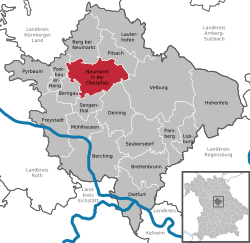Neumarkt in der Oberpfalz
Neumarkt in der Oberpfalz (German: [ˈnɔɪ̯maʁkt ʔɪn deːɐ̯ ˈʔoːbɐˌpfalts] (![]() listen); Bavarian: Naimakk in da Owerpfolz) is the capital of the Neumarkt district in the Upper Palatinate, in Bavaria, Germany.
listen); Bavarian: Naimakk in da Owerpfolz) is the capital of the Neumarkt district in the Upper Palatinate, in Bavaria, Germany.
Neumarkt in der Oberpfalz | |
|---|---|
 Aerial view of Neumarkt | |
Location of Neumarkt in der Oberpfalz within Neumarkt in der Oberpfalz district | |
| Coordinates: 49°17′N 11°28′E / 49.283°N 11.467°E | |
| Country | Germany |
| State | Bavaria |
| Admin. region | Oberpfalz |
| District | Neumarkt in der Oberpfalz |
| Government | |
| • Lord mayor (2017–23) | Thomas Thumann[1] (FW) |
| Area | |
| • Total | 79.03 km2 (30.51 sq mi) |
| Elevation | 424 m (1,391 ft) |
| Population (2022-12-31)[2] | |
| • Total | 40,808 |
| • Density | 520/km2 (1,300/sq mi) |
| Time zone | UTC+01:00 (CET) |
| • Summer (DST) | UTC+02:00 (CEST) |
| Postal codes | 92318 |
| Dialling codes | 09181 |
| Vehicle registration | NM, PAR |
| Website | www.neumarkt.de |
Geography
changeNeumarkt is on the western edge of the Franconian Jura, settled in a valley. The municipal region reaches as far as the Bavarian Jura to the east. The Neumarkt valley releases to the north through the Schwarzach River, a tributary of the Regnitz, flowing into the Main, and to the south through the Sulz, a tributary of the Altmühl, which flows into the Danube. The Ludwig Canal cuts through the area from North to South. The elevation ranges from 406 meters on the Beckenmühle River to the north, to 595 meters in the quarter of Fuchsberg. The elevation of city hall is given as 423 meters.
The municipal region has an area of 73.09 km2. The following municipalities, all of which belong to the Neumarkt district, border the district capital. They are named clockwise, beginning in the north: Berg, Pilsach, Velburg, Deining, Sengenthal, Berngau and Postbauer-Heng.
Municipal subdivision
changeThe center of the municipal area is the Old City and its borders. The first housing developments built outside the city walls began in 1850 to the east, along Mühlstraße, Mariahilfstraße, and Badstraße. To the south, the Industrial area developed beginning around 1920. After 1945, the city expanded to the north and west, and grew together with the municipalities of Woffenbach and Holzheim. Many other settlements developed around the city center, named, going clockwise from the north: Altenhof, Koppenmühle, Kohlenbrunnermühle, Mühlen, Wolfstein (at the site of the former Prison Work Camp), Weinberg, Schlosserhügel, and Hasenheide.
During the 1972 Municipality Reforms, nine municipalities were combined with the city, increasing the municipal area.
References
change- ↑ Liste der ersten Bürgermeister/Oberbürgermeister in kreisangehörigen Gemeinden, Bayerisches Landesamt für Statistik, accessed 19 July 2021.
- ↑ Genesis Online-Datenbank des Bayerischen Landesamtes für Statistik Tabelle 12411-003r Fortschreibung des Bevölkerungsstandes: Gemeinden, Stichtag (Einwohnerzahlen auf Grundlage des Zensus 2011) .



